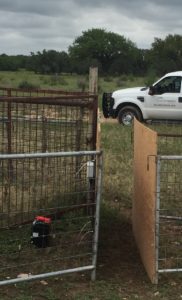AgriLife eyes ways to match offspring with their dams using new producer-friendly technologies
Writer: Steve Byrns, 325-653-4576, [email protected]
Contact: Dr. Reid Redden, 325-653-4576, [email protected]
SAN ANGELO – The age-old problem of matching ewes with their offspring is getting some help from modern technology, said a Texas A&M AgriLife Extension Service expert.
“For a sizeable group of animals, matching lambs with their mothers can turn into a logistical and economic nightmare,” said Dr. Reid Redden, AgriLife Extension state sheep and goat specialist at San Angelo. “The practice requires time, facilities and added feed costs. Plus, the animals are often in an unfamiliar environment very dissimilar to their normal pasture setting. All of this adds stress to the animals.”
Redden said matching ewes and does with their lambs or kids has long been an arduous, often frustrating task.
“Texas has the potential to greatly increase the lamb and kid crop by selection of twin-born and reared offspring,” he said. “Unfortunately, most replacement lambs and kids are selected without this information, which has halted progress in reproductive efficiency.”
Redden said parentage is imperative for the serious livestock breeder seeking to make genetic improvement within their flocks and herds. Parentage is possibly even more important for the seedstock breeder who sells to others based on his or her credibility and that of their animals.
Traditionally, ranchers wanting to determine their animals’ parentage would bring females into small areas during the lambing and kidding period to match up offspring with their dams at birth or very soon thereafter.
Two vastly different technologies are now within easy reach of most producers. The technologies can turn a chore into something the animals tend to themselves in one method or into a simple one-time procedure in the other, Redden said.

“Radio frequency identification, referred to as RFID, usually applied as an ear tag and genetic testing are the newer available technologies,” he said. “Both allow ranchers to determine parentage of lambs or kids without intervening in the lambing or kidding process.”
RFID ear tags determine parentage of lambs or kids to their dams by the frequency they travel through a check station, since offspring will trail behind their dams, Redden said.
“Both dam and offspring must have an RFID tag and must travel at their own speed through a narrow check station, usually two sheets of plywood with the tag reader mounted on one, for a couple of weeks,” he said. “Since this little chute must be narrow enough for animals to pass single file, they need to be accustomed to it prior to use.”
Redden said the animals can be trained by placing the plywood panels wide-apart somewhere the animals must pass on their own volition. He recommends starting well in advance of lambing or kidding and gradually moving the plywood panels closer together until the animals are comfortable passing through it in single-file.
Redden cautioned that RFID technology is more accurate when the lambs and kids are young, because the older they are, the more independent they become and thus are less apt to follow their dams as closely. He also said to work properly, the animals must pass regularly by the chute mounted reader, so if for example the chute leads to the pasture water source, it must be the only one in the pasture, including puddles left after a rain.
The ewes followed by the lambs must pass the reader about 25 times to ensure the same lambs are following the same ewe, their mother, he said.
Redden said the AgriLife faculty in San Angelo tested an Australian made product, PedigreeScan reader and KoolCollect software, Sapien Technology, Victoria, Australia, and found it to be very accurate in correctly matching ewes with lambs. The cost of the unit is $3,000 and the cost of the software is $600.
“There is a U.S. RFID service provider, Gene Edminston Consulting, that uses the same scanning unit to match offspring to dams, but flock managers don’t have to buy and have to learn how to use the software,” Redden said. “AgriLife also tested this service provider and found this technique was equal to or better able to match lambs to ewes than the Australian software. Edminston charges $1 per head for the service and does reserve a minimum and maximum test number.”
Genetic testing is the other newer technique Redden said ranchers could use to determine parentage of their animals.
“This technology only requires a rancher take a small blood sample and place it on a blood card with the animal’s individual identification number,” he said. “There are numerous U.S. genetic testing companies that provide this service. GeneSeek, Lincoln, Nebraska, is a commonly used service provider. They charge $25 per head to have the animal tested.
“Initially, this cost would apply to all lambs, ewes and rams within a flock, but future testing would only apply to the lambs, because the ewes and rams would have already been tested. This technique in the future could also be expanded into a single test for a wide range of genetic markers, such as scrapie codon, polled gene, spider lamb, etc.”
For more information, contact Redden at 325-653-4576, or [email protected] .


